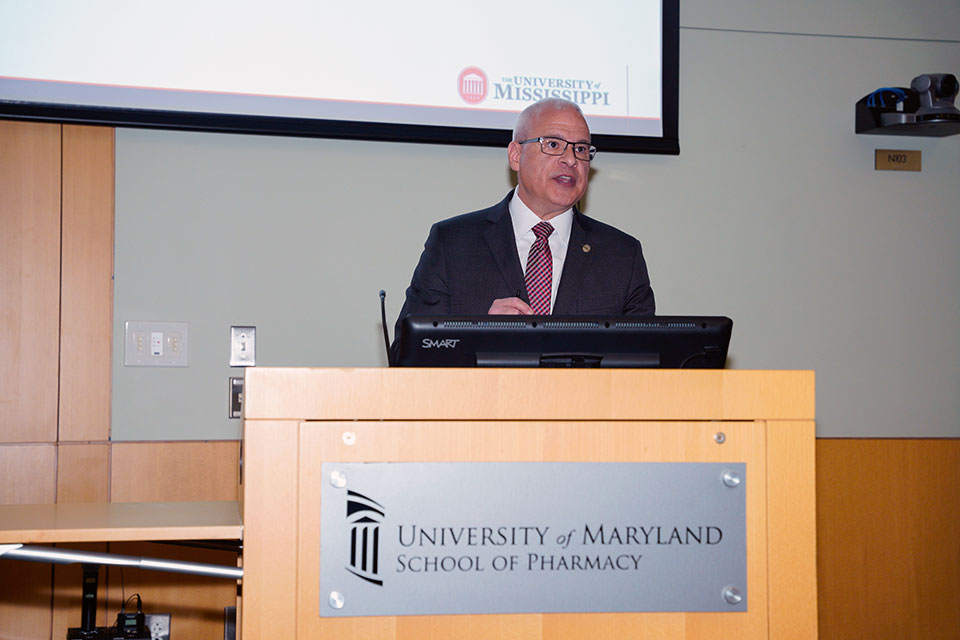DuMez Lecture Presents Modern Method to Revamp Warfarin Management
Speaker Henry Bussey highlights his efforts to develop a new, online program to improve the safety and efficacy of key anticoagulation drug.
By Malissa Carroll
April 28, 2014
Henry I. Bussey, PharmD, president and senior editor of ClotCare.org and president of ClotFree Texas, delivered the annual Andrew G. DuMez Memorial Lecture at the University of Maryland School of Pharmacy on April 14. Titled “Does a New Way of Managing Warfarin Make the Newer Oral Anticoagulants Obsolete?”, the lecture spotlighted how data gathered from five online anticoagulation management systems suggest that the safety, efficacy, and ease of use of warfarin can be achieved. One of the online systems featured was ClotFree, which Bussey developed with his daughter, Marie Bussey.
Often prescribed for patients who recently suffered a heart attack, or those with certain types of irregular heartbeat or prosthetic heart valves, warfarin is used to prevent blood clots from forming in blood vessels. “In the United States, there are more than 15 million people who should be taking anticoagulation medication. However, only approximately three million people have been prescribed warfarin. People do not like to use this drug because it can be very time consuming and difficult to manage,” said Bussey.
Because the goal of warfarin therapy is to decrease the blood’s ability to clot — not to prevent clotting completely — patients who take this medication must be carefully monitored with frequent blood testing. Based on the test results, health care providers adjust patients’ daily dose of warfarin to keep clotting ability within a target range, known as the International Normalized Ratio (INR).
“By using warfarin and keeping the INR in range, we can achieve a more than 80 percent reduction in the risk of stroke among patients with atrial fibrillation,” said Bussey. “This is hugely beneficial, but the problem is that it is often very difficult to keep the INR in range. Poor adherence to the medication, as well as small changes in patients’ diets, exercise habits, or consumption of drugs and alcohol can affect the INR, which underscores the importance of frequent blood testing.”
The Food and Drug Administration approved warfarin as a medication in 1954, which Bussey slyly noted was about the same time that the Volkswagen (VW) Beetle started to gain popularity in the United States. “I have disassembled and reassembled a couple of old VW Beetles. They are cute, but cumbersome, and often require frequent maintenance — which also describes the current state of anticoagulant management. We’ve been driving the 1954 VW Beetle, even as the world continues to change and advance around us,” he said.
However, Bussey believes that he has found a solution to this problem in ClotFree — his new, online management system for warfarin — which he describes as “simpler, easier, and more efficient” than managing the drug in a clinic.
Patients participating in ClotFree perform an at-home finger stick blood test according to a pre-determined schedule and self-report their results in a secure website designed by Bussey and his daughter. Each patient’s pharmacist or other health care provider reviews the results and makes adjustments to the patient’s warfarin dose as necessary. The website notifies the patient of any changes in dose as reported by his or her health care provider, which the patient implements into his or her daily medication regimen.
“The time required for the patient to perform the test, answer a series of questions online, and report the INR result is approximately 10 minutes,” said Bussey. “For the provider, if there are no changes to report, the review process takes less than one minute of his or her time. If the provider needs to dialogue with the patient, the average time required to complete the process is less than three minutes. One person can manage everything. There is no need for support staff.”
He mentioned, though, that the road to implementing this system has not been a smooth one.
“Any time that you try to change a current method or standard, you encounter obstacles,” said Bussey. “Most people like to maintain the status quo, and the people who will benefit from the change are not completely sold on it because they have not had a chance to experience it. My daughter and I were confident in our idea, but a lot of people were reluctant to embrace the concept. We were building a sports car, but had nowhere to drive it.”
Eventually, Bussey found a test driver in the Chest Foundation of the American College of Chest Physicians, which awarded him the competitive, three-year Distinguished Scholar in Thrombosis Award to develop and test his program. And, as he noted, “The more we drove the sports car, the more we liked it.”
“It’s time to park the old VW Beetle,” concluded Bussey. “While most efforts to improve INR control among patients on warfarin have shown an increase of three to five percent, the study conducted using our program showed an increase of 25 percent. We are convinced that this system can help reduce strokes, heart attacks, major bleeds, and mortality by approximately 50 percent. In addition, the estimated reduction in health care costs as a result of patients experiencing fewer adverse events averages $2,000 to $5,000 per patient, per year. That does not include the additional savings that may result from eliminating routine clinic visits and avoiding the high costs associated with the newer anticoagulant medications.”



